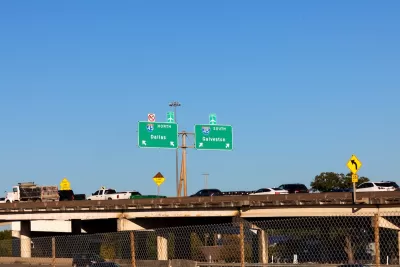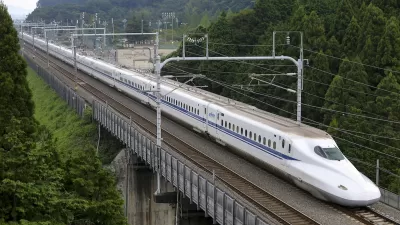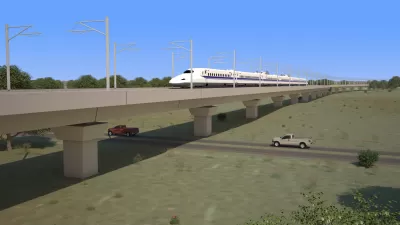The proposed rail line would link Dallas and Houston via a 90-minute trip.

Updated September 20 to include a response from the North Central Texas Council of Governments.
Texas officials say they will use eminent domain to acquire land needed for the 240-mile high-speed rail line planned between Dallas and Houston, reports Hugh Cameron in Newsweek. The Texas Supreme Court ruled that the project’s builder had eminent domain authority in one Leon County case in 2022.
According to a proposal presented to the Regional Transportation Council of the North Central Texas Council of Governments, the project requires the creation of a statewide high-speed rail authority. “This, they state, would require ‘provid[ing] counties and cities with expanded tools for land use control to preserve future transportation corridors and support land use, housing, school, and transportation connection policies that best serve growth needs.’” According to Texas Central, the train could remove up to 12,500 cars from Interstate 45 each day.
The project has gained momentum in recent months, with the federal government awarding Amtrak a $64 million grant for the line earlier this month, but its total estimated cost has gone up from $10 billion to over $33 billion as of a 2023 study.
In an email to Planetizen, a spokesperson for the North Central Texas Council of Governments clarified, “While the draft legislative proposal mentions eminent domain, it does so in the context of calling for continued support for the current statutory authority for local governments involved in the development of a freeway project, not high-speed rail. The goal is to retain local control of something that already exists.” The email also noted that the creation of a statewide high-speed rail authority is just one proposed avenue for moving the project forward.
FULL STORY: Texas Lawmakers Plan To Seize Land for Bullet Trains

Alabama: Trump Terminates Settlements for Black Communities Harmed By Raw Sewage
Trump deemed the landmark civil rights agreement “illegal DEI and environmental justice policy.”

Planetizen Federal Action Tracker
A weekly monitor of how Trump’s orders and actions are impacting planners and planning in America.

The 120 Year Old Tiny Home Villages That Sheltered San Francisco’s Earthquake Refugees
More than a century ago, San Francisco mobilized to house thousands of residents displaced by the 1906 earthquake. Could their strategy offer a model for the present?

BLM To Rescind Public Lands Rule
The change will downgrade conservation, once again putting federal land at risk for mining and other extractive uses.

Indy Neighborhood Group Builds Temporary Multi-Use Path
Community members, aided in part by funding from the city, repurposed a vehicle lane to create a protected bike and pedestrian path for the summer season.

Congestion Pricing Drops Holland Tunnel Delays by 65 Percent
New York City’s contentious tolling program has yielded improved traffic and roughly $100 million in revenue for the MTA.
Urban Design for Planners 1: Software Tools
This six-course series explores essential urban design concepts using open source software and equips planners with the tools they need to participate fully in the urban design process.
Planning for Universal Design
Learn the tools for implementing Universal Design in planning regulations.
Clanton & Associates, Inc.
Jessamine County Fiscal Court
Institute for Housing and Urban Development Studies (IHS)
City of Grandview
Harvard GSD Executive Education
Toledo-Lucas County Plan Commissions
Salt Lake City
NYU Wagner Graduate School of Public Service





























